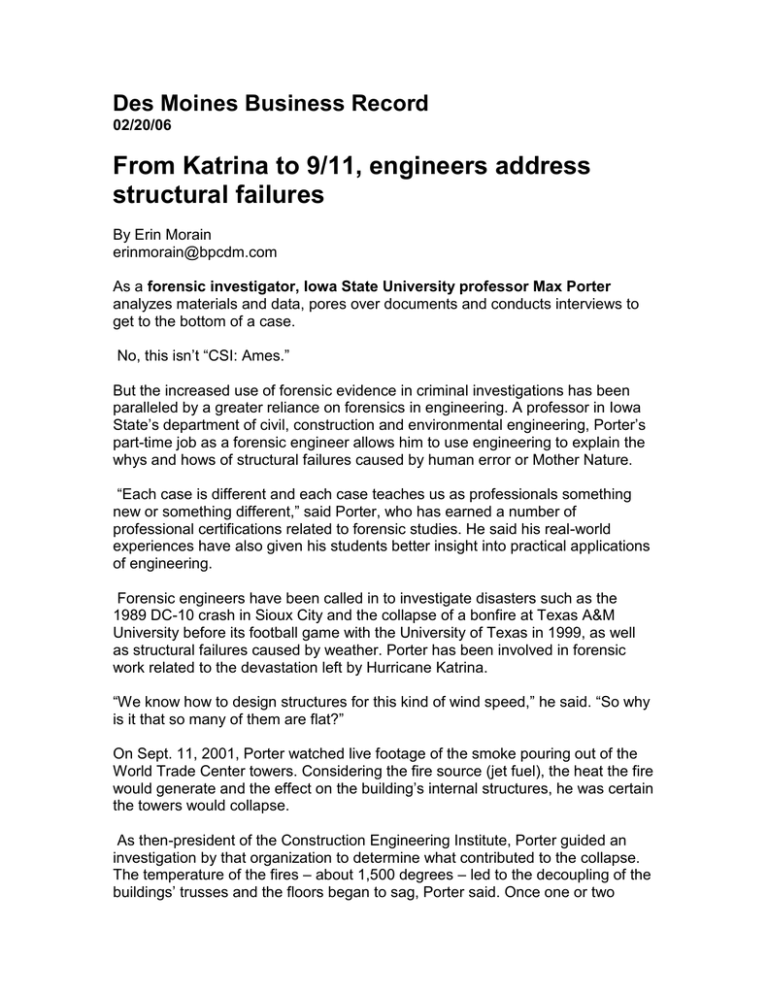From Katrina to 9/11, engineers address structural failures Des Moines Business Record
advertisement

Des Moines Business Record 02/20/06 From Katrina to 9/11, engineers address structural failures By Erin Morain erinmorain@bpcdm.com As a forensic investigator, Iowa State University professor Max Porter analyzes materials and data, pores over documents and conducts interviews to get to the bottom of a case. No, this isn’t “CSI: Ames.” But the increased use of forensic evidence in criminal investigations has been paralleled by a greater reliance on forensics in engineering. A professor in Iowa State’s department of civil, construction and environmental engineering, Porter’s part-time job as a forensic engineer allows him to use engineering to explain the whys and hows of structural failures caused by human error or Mother Nature. “Each case is different and each case teaches us as professionals something new or something different,” said Porter, who has earned a number of professional certifications related to forensic studies. He said his real-world experiences have also given his students better insight into practical applications of engineering. Forensic engineers have been called in to investigate disasters such as the 1989 DC-10 crash in Sioux City and the collapse of a bonfire at Texas A&M University before its football game with the University of Texas in 1999, as well as structural failures caused by weather. Porter has been involved in forensic work related to the devastation left by Hurricane Katrina. “We know how to design structures for this kind of wind speed,” he said. “So why is it that so many of them are flat?” On Sept. 11, 2001, Porter watched live footage of the smoke pouring out of the World Trade Center towers. Considering the fire source (jet fuel), the heat the fire would generate and the effect on the building’s internal structures, he was certain the towers would collapse. As then-president of the Construction Engineering Institute, Porter guided an investigation by that organization to determine what contributed to the collapse. The temperature of the fires – about 1,500 degrees – led to the decoupling of the buildings’ trusses and the floors began to sag, Porter said. Once one or two floors began to give way, he said, the entire building was likely to collapse. In addition, the force of the airplanes knocked off the fireproofing material in those areas of the building. “Had that remained bonded to the structural steel members so the fireproofing could do its job, we’d like to think maybe that building would have stood for one heck of a lot longer period of time,” Porter said. Investigative work into the collapse of the towers has been ongoing since the terrorist attacks and has led to discussions about changes in design standards. But the issue at hand is whether tougher design standards would force builders to use unaffordable materials. “If a building is going to fall down and kill people, we have an ethics problem,” he said. “But the other aspect is what kind of risk people are willing to take that this is going to happen again.” The responsibility for preventing such accidents lies in the hands of the entire team, from the engineers to the building owners, Porter said. He also points to the issue of low bids and the occasional tendency to cut corners. “They might pay a cheaper price upfront, but they’ll have to do a lot of maintenance later on,” he said.


![[5] James William Porter The third member of the Kentucky trio was](http://s3.studylib.net/store/data/007720435_2-b7ae8b469a9e5e8e28988eb9f13b60e3-300x300.png)


